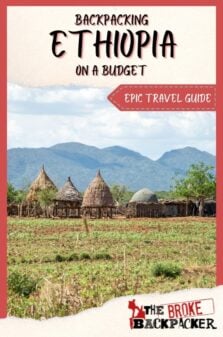The Broke Backpacker is supported by you. Clicking through our links may earn us a small affiliate commission, and that's what allows us to keep producing free content 🙂 Learn more.
Would you be up to traveling 7 years back in time? What about experiencing the sunrise at 1 am?
Ethiopia is a unique and magical country. They have their own calendar (they are right now in 2015), hours (they start counting from sunrise) and religion (Ethiopian Orthodox), and it is home to more than 90 ethnic groups and 80 languages.
If you are willing to know Ethiopia beyond the horrible events that have affected it over the last decades, you will discover a country with a history that dates back to more than 3,000 thousand years ago, which is not particularly common in Sub-saharan Africa, and with some of the most astonishing historical and natural sites in the world.
Nonetheless, Ethiopia is a country that has been severely affected by poverty, armed conflicts and political instability, which have made backpacking Ethiopia a challenging experience. Hence, traveling to Ethiopia is not for everyone.
Only for those of you who believe that adventure and getting out of the comfort zone are essential parts in life, I have prepared this detailed Ethiopia travel guide to help you embark on one of the most remarkable experiences of your life.
Let’s get to it.
Who Go Backpacking in Ethiopia?
Ethiopia is, together with Liberia, the only country in Africa that was never colonized. This is a huge source of pride for Ethiopians and has allowed the country to maintain its culture and traditions isolated from colonial influence. It also makes traveling in Ethiopia feel like you are getting into a completely different world.
I have lived in Ethiopia for more than five months and I can assure you that it doesn’t matter how much time you spend there, Ethiopia will keep on surprising you until the day you leave.
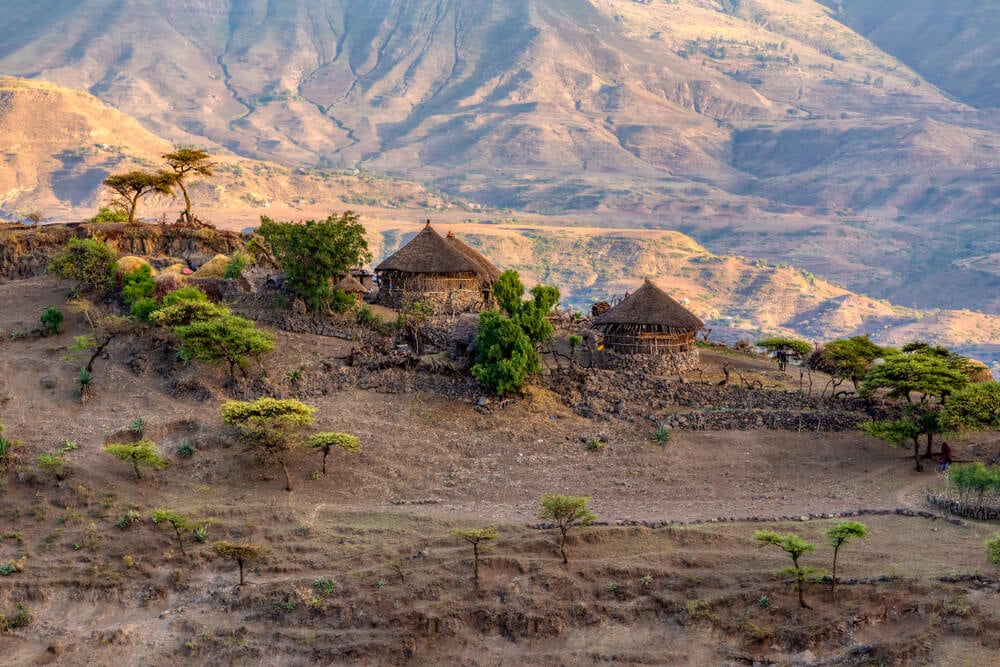
The Broke Backpacker is supported by you. Clicking through our links may earn us a small affiliate commission, and that's what allows us to keep producing free content 🙂 Learn more.
Traveling around Ethiopia is an experience full of emotions. You will witness huge economic differences and chaos. You will constantly be stared at. You will experience the high levels of religiosity and mysticism that govern Ethiopian society. You will enjoy a radically unique gastronomy. And, above all, you will experience enormous diversity.
History in the north, tribes in the south, and Islamic influence in the east, all surrounded by magnificent landscapes and natural attractions, make Ethiopia the perfect travel destination for those who like to avoid monotony in their trips.
Best Travel Itineraries for Backpacking Ethiopia
Ethiopia is a huge country of the size of France and Spain combined. The vast amount of amazing sites to visit and the depth of its diverse culture and its ancient history would allow you to spend several months in the country without having discovered half of it.
The northern part of Ethiopia is more historical, although it also has some natural attractions like the Simien Mountains and the Danakil Depression, while the southern part of the country may be better for serious adventure travelers willing to immerse more into the wildlife and the tribes Ethiopia is home to.
10-Days Travel Itinerary for Ethiopia – The Historical North

It must be said that 10 days are not enough to visit the whole country, however, with this itinerary through the northern part of Ethiopia, you can get a strong idea about its culture and the ancient history that has shaped the country in such a unique manner. The itinerary is reduced to the Amhara region, which was home to the different Ethiopian capital cities and kings for centuries.
If you access Ethiopia by plane, which is the most common and recommended way to enter the country, every trip will start in Addis Ababa. Even though there may not be too many astonishing attractions in Addis, I would recommend spending at least one day until you head on to the next destination.
It is possible to reach Bahir Dar by public transportation, however, with a constrained calendar it may be better to get there by plane as it can easily take a whole day to reach it. From there, you can move from one place to another with public buses or hire a driver to take you around.
I would spend at least a whole day in Bahir Dar and Gondar and then spend at least two whole days both in the Simien Mountains and Lalibela. In the latter, it would be recommendable to save a day to hike to the monasteries in the area, although you can see even more if you have time.
I wouldn’t recommend spending less than 10 days in Ethiopia.
18-Days Travel Itinerary for Ethiopia – The Historical North & The East

This itinerary adds two more destinations to the previous one.
From Lalibela, you could head on by public transportation to Semera, where all the organized trips to the Danakil Depression are currently starting. Organized trips are compulsory to visit Danakil Depression and they usually vary from 1 to 4 nights.
Depending on your interest and time and budget constraints, I would advise going for the 2 or 3 nights tours. Before the Tigray conflict started, it was also possible to start organized trips from Mekele.
The trip will take you back to Semera from where you can take a long bus ride to Harar, where you can explore the city and embark in the available activities for one or two days. There is no airport in Harar, however, Dire Dawa, the second largest city in the country is close and you can fly back to Addis from there.
1-Month Travel Itinerary for Ethiopia – The Whole Country
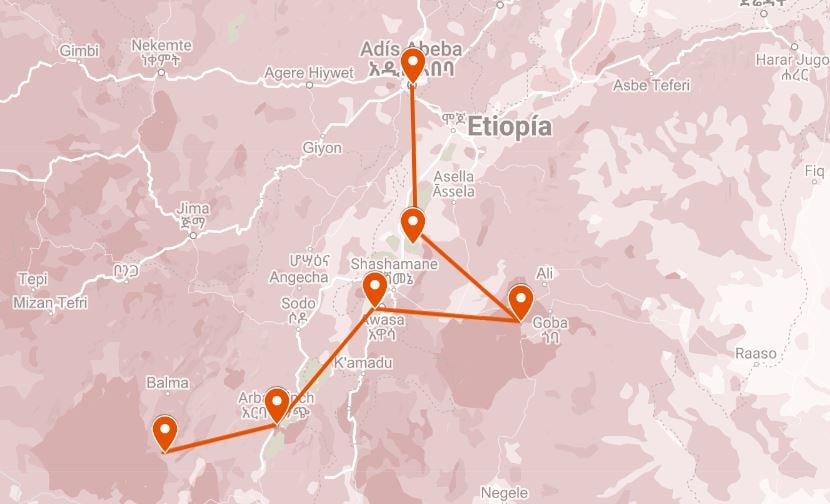
This itinerary includes the previous one and the southern part of the country and it will allow you to fully explore the huge cultural diversity existing within Ethiopian society. This itinerary can also serve those more interested in exploring the southern part of Ethiopia.
Regardless of whether you have already done the northern itinerary or just arrived in the country, to explore the south, you should start in Addis. This itinerary is done for those willing to travel this area by land and willing to spend between 10 and 14 days.
Nonetheless, the main motivation to travel to this area is usually to reach Arba Minch or Jinka, where you can access tribal and wildlife experiences. Therefore, it is also possible to access these two cities directly by plane and spend the whole time there.
If going by land it would be recommendable to spend one night both in Langano and Awasha and at least a couple of them in the Bale Mountains, the place in the country where it’s easier to spot the Ethiopian Wolf.
On your way south, you can also visit the Rastafari community of Shashamane, although it is not 100% advisable due to reported incidents towards tourists.
Once in Arba Minch and Jinka, it is generally compulsory to hire a tour operator to embark on tribal experiences, usually located inside the National Parks.
To go back to Addis, you can fly from both cities.
Best Places to Visit in Ethiopia
Backpacking Ethiopia is all about experiencing the enormous diversity and uniqueness of its different destinations.
From walking through its vibrant capital city to being completely unable to communicate in isolated villages, Ethiopia offers attractions for all kinds of preferences and is a true treat for slow travelers.
Backpacking Addis Ababa
Addis, as the locals refer to it, is known to be the diplomatic capital of Africa as it hosts the African Union headquarters. Even though it may not have the most beautiful sites, I would recommend spending at least one or two days exploring the city. Compared to other African capital cities it is relatively safe to walk around.
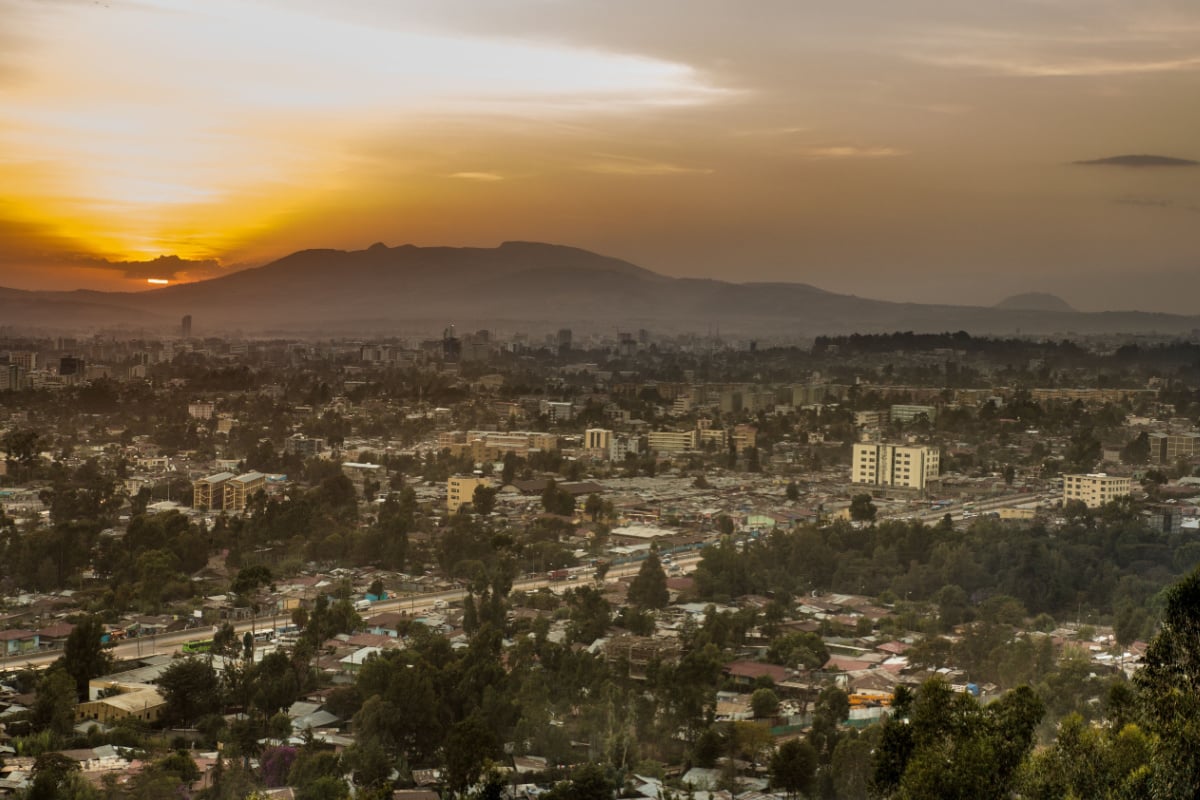
The main attractions in Addis would be the National Museum, the Ethnological Museum, and, of course, Merkato, the biggest open-air market in Africa, where you can wander around its busy narrow streets and experience the life of the country’s trade center. Addis also offers the best nightlife and gastronomical options in the whole country.
Backpacking Lalibela
Probably the most important tourist attraction in the whole country. However, it must be said that its popularity is well deserved. It’s one of those destinations that will appeal to everyone from hardcore budget backpackers to luxury tour groups.
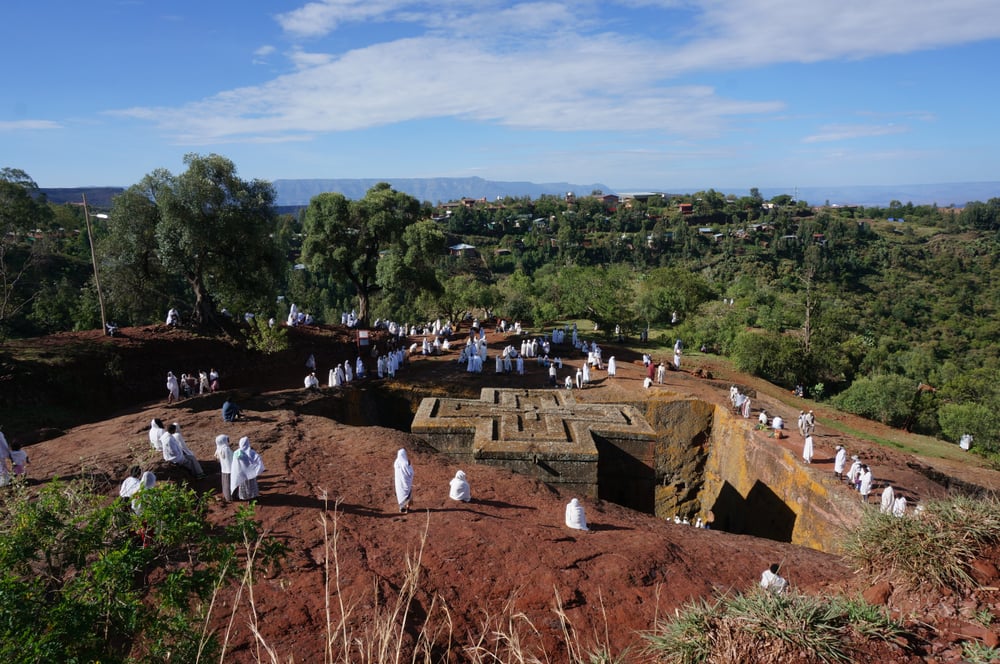
The town of Lalibela is home to a group of 11 rock-hewn churches from the 12th century. These churches were carved from the ground and, hence, built from top to bottom. They were built underground so that the enemies wouldn’t be able to spot them from a long distance.
Besides its beauty and historical interest, what makes Lalibela unique and different from other historical attractions is that it continues to have a high degree of religious activity. While visiting Lalibela you will encounter hundreds of pilgrims and priests praying and camping in the churches’ compound. Just remember to take off your shoes before entering a church.
Backpacking Gondar
The historical city of Gondar is located in the northwest of the country and it will be the first relatively big city you will find if you are entering Ethiopia by land from Sudan.

Gondar was the capital city of the Kingdom of Abyssinia until the second half of the 19th century and it’s home to the Fasil Ghebbi citadel where the successive kings since the 17th century built their castles.
It is not necessary to spend more than one day in Gondar and it’s a perfect stopover on your way to the Simien Mountains National Park.
Backpacking Simien Mountains
The “Roof of Africa”, as it is also known, is an extensive National Park with more than a dozen peaks with a height of more than 4,000 meters. It is also home to Ethiopian endemic animals like the walia, the gelada monkey and the Ethiopian wolf.

The Simien Mountains are located 2 hours north from Gondar by car. It is highly recommendable to spend at least one night camping in the national park in order to enjoy sunrise and sunset treks. However, it is possible to extend the trek up to a week and reach Ras Dashen’s peak, the highest mountain in Ethiopia.
It is compulsory to be accompanied by a scout during your stay in the Simien Mountains and it is also recommendable to hire a guide who knows the National Park, especially if you are not planning to stay too much time inside, as it has a wide range of alternative paths that can led you to end up a bit lost.
Backpacking Bahir Dar
Located on the south coast of Lake Tana, the biggest lake in Ethiopia, Bahir Dar is the third biggest town in the country and is the capital city of the Amhara region. The main attraction in Bahir Dar is the monastery islands inside of the lake, where you can see how priests devote their time to their spiritual duties in an incredibly charming and isolated environment.
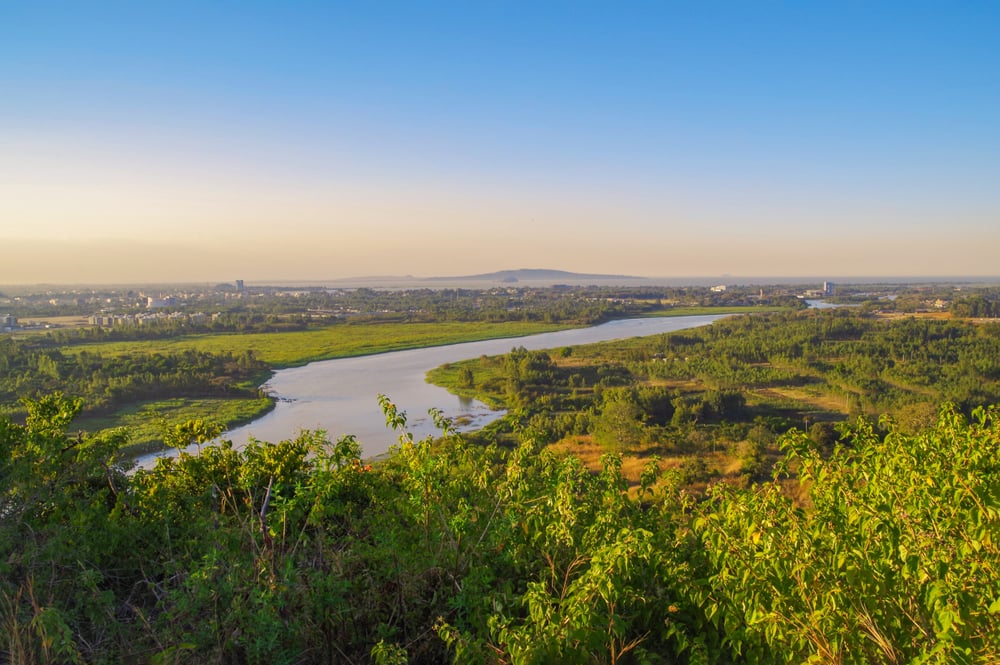
While in Bahir Dar, it is also recommendable to go on a one-hour drive to the Blue Nile Falls. The best time to visit the falls is during the rainy season, when the falls are wider and more powerful, and the landscape surrounding them is greener. Nonetheless, they can also be visited during the rest of the year but before going it is advisable to check out if the activity of the dam nearby is shortening the water supply to the falls.
Besides these attractions, Bahir Dar is a charming city with the comforts of a metropolitan area but without the overwhelm that you may find in Addis Ababa.
Backpacking Danakil Depression
This area located in the Afar region some 15 km away from the border with Eritrea, in the northeast of Ethiopia, is considered the most inhospitable place on Earth because of its high temperatures (usually around 50º degrees Celsius) and the presence of active volcanoes and high quantities of sulfur.

However, a trip to the Danakil Depression also offers the opportunity to immerse in one of the most unique landscapes in the world. You will be able to see the work of the rough Afar miners in the salt lakes, the picturesque colors of Dallol, and the active Erta Ale volcano.
The inhospitality of the region makes it compulsory to be accompanied by armed scouts during your visit to the Danakil Depression. In addition, the trip involves long driving hours through a difficult environment. Hence, you should organize your trip to Danakil with a travel company, which will start the trip from Mekele (currently not available because of the conflict situation in Tigray) or Semera. Prices are high but it is the only way to visit this remote land.
Backpacking Harar
The walled city of Harar is located in the eastern part of Ethiopia, close to the border with Somaliland. As in much of this part of Ethiopia, Islam is the dominant religion, and Harar features the characteristics of Arabic-style architecture and urban design.
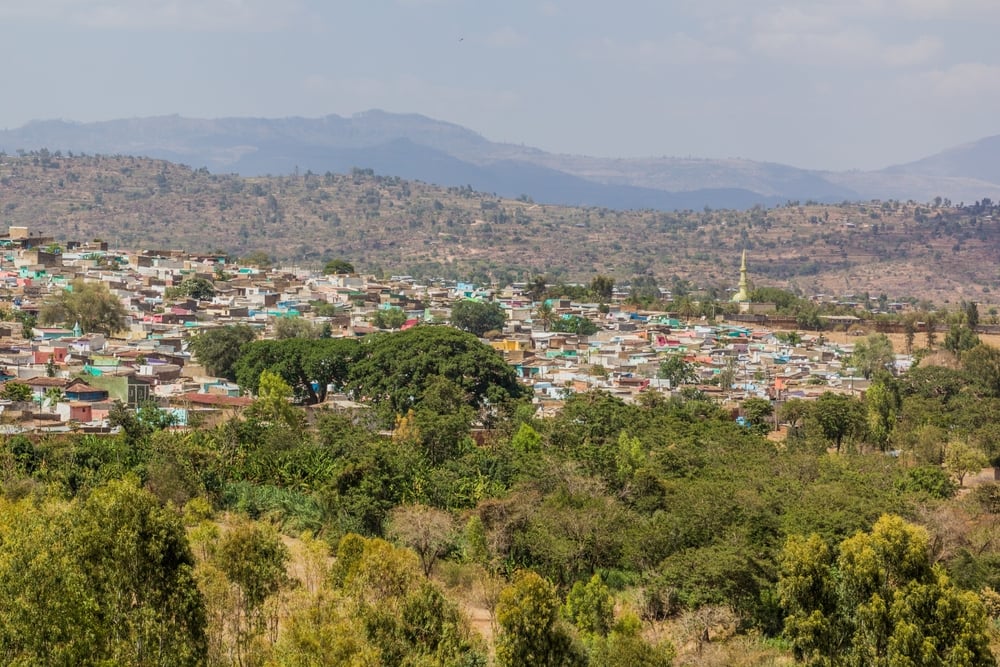
One of the biggest charms that Harar offers is getting lost through its narrow streets to appreciate the lifestyle of the inhabitants of this 13th-century town. In addition, during sunset, it is possible to get outside of the city walls and feed the hyenas that abundantly populate Harar.
Like in other parts of Ethiopia and the Horn of Africa, many of the inhabitants of Harar will spend several hours per day chewing khat. This plant with stimulant effects must be chewed for hours in order to truly notice its effect.
Backpacking Arba Minch
Arba Minch is the most populated city in the southern part of Ethiopia. It is located beside lakes Chamo and Abaya. A boat cruise in Lake Chamo will offer you the opportunity to spot hippos and Nile crocodiles, the biggest kind in the world, apart from the lifestyle of the intrepid fishermen who embark every day in these dangerous waters.
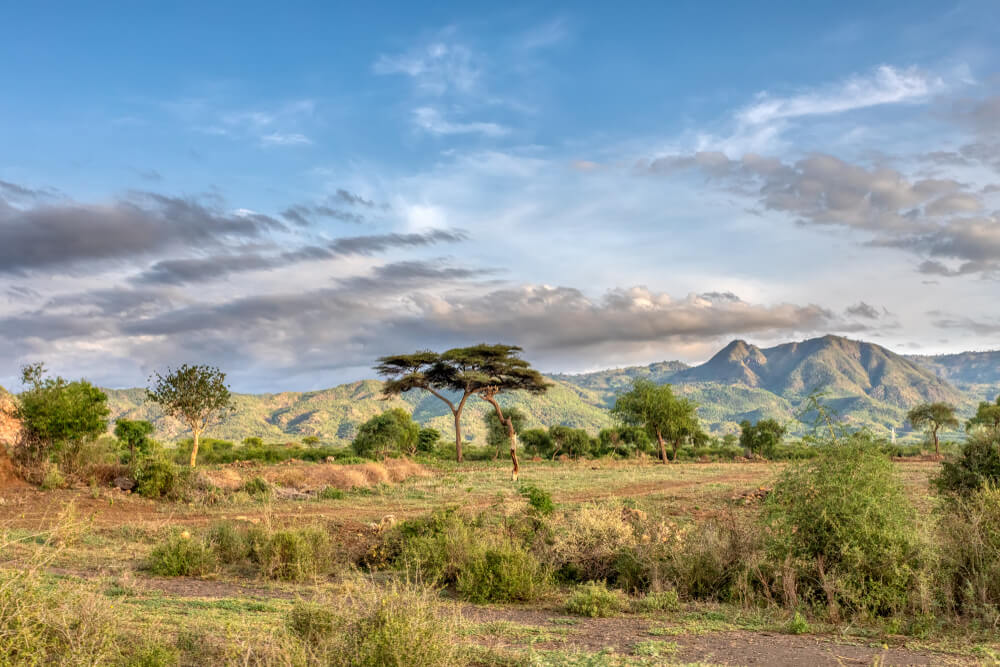
Arba Minch is often used by visitors as the base to explore the different indigenous tribes that populate this part of the country. A two-hour drive to the south from Arba Minch you can find the UNESCO village of Konso, where the Konso people live in a centuries-old walled town.
The city of Jinka, located to the southwest of Arba Minch, is also used as a base to explore the remote tribes of the Omo Valley. However, this experience has a high cost and, from a personal opinion, is a bit uncomfortable to just wander around a place where the only reason why they accept you being there is that you are paying them.
Getting Off the Beaten Path in Ethiopia
Backpacking Ethiopia is in itself an off the beaten path experience. Even in Lalibela, the “most touristic” attraction in the country you will find out that 90% of the people are there for non-touristic reasons.
Having said this, Ethiopia also offers the opportunity to immerse in communities and villages that live 100% isolated from the outside world, without internet access and reliant on traditional trade rather than on the use of currency.
When traveling Ethiopia by land, it is easy to recognize this kind of town and I will highly encourage you to spend a couple of hours trying to interact with the locals there. However, don’t expect them to know English.

We’ve tested countless backpacks over the years, but there’s one that has always been the best and remains the best buy for adventurers: the broke backpacker-approved Osprey Aether and Ariel series.
Want more deetz on why these packs are so damn perfect? Then read our comprehensive review for the inside scoop!
View on Osprey
A new country, a new contract, a new piece of plastic – booooring. Instead, buy an eSIM!
Jetpac eSIMs work just like an app: you download it, pick your plan, and BOOM! You’re connected the minute you land. It’s that easy.
Read about how e-Sims work or click below to see one of the top eSIM providers on the market and ditch the plastic.
Grab an eSIM!Top Things to Do in Ethiopia
These are the best things to see and do in Ethiopia…
1. Explore Lalibela
Probably one of the highlights and indispensable destinations when traveling in Ethiopia. Despite the beauty and the magnificent architectural characteristics of Lalibela, wandering around the churches’ compound and observing how people behave inside the churches is the best way to understand the degree of religiosity of Ethiopia.
Depending on the time you have you can decide whether to do this on your own or with a local guide. If you have time constraints I will highly recommend hiring a guide to show you all the highlights in the compound.
2. Camp in the Simien Mountains
After having spent some days exploring the overwhelming streets of different Ethiopian sites, arriving at the Simien Mountains feels like entering an oasis in the middle of the desert.
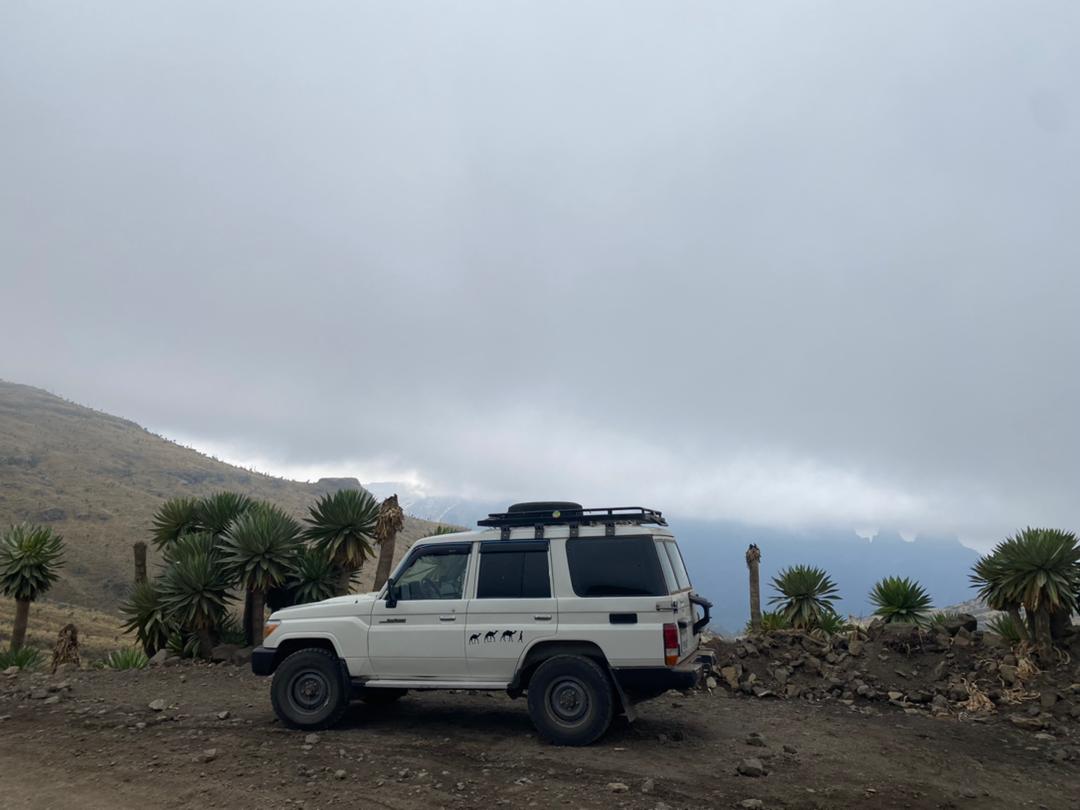
You should spend at least one night to experience one of the best sunsets that you will ever see. Standing on the edge of a 4000 meters high mountain while the sun comes down and the Gelada monkeys start climbing the cliffs to find the place where they will spend the night is one of the most beautiful natural experiences in the whole world.
While trekking, it is important to pay attention to the endemic Ethiopian wolf, who may surprise you while trying to hunt some moles in the ground. Also, remember to bring your winter clothes as during the night it gets freezing cold.
3. See the Danakil Depression
Besides its reputation as the most inhospitable place on Earth, embarking on a Danakil Depression trip is a hell of an adventure. Whether you spend 2,3 or 4 nights there, visiting Danakil is one of those experiences that make you feel relieved they are over while at the same time, you don’t regret having gone through them.
The heat, the lack of showers, or the armed company, are clearly compensated by the feeling of entering a whole new planet in which all your five senses will be exposed to radically new sensations.
4. Discover the Island Monasteries in Lake Tana
Hire a boat to take you around Lake Tana, exploring its completely isolated and peaceful island monasteries. There are five of them, however, it may be enough to arrange with the boat captain to just visit three or four.

Debre Maryam is the most popular one and has a bigger tourist infrastructure with shops and bars, thus, while worth spending half an hour there, you should head on to smaller and more isolated ones like Daga Stefanos or Kergan Gabriel.
In these monasteries, you will most certainly be the only person on the island besides the priests that live there and who dedicate their lives to praying and meditating in such a quiet, green and peaceful environment. During your boat ride you will also be able to spot hippos.
5. Get lost in the streets of Harar
For those travelers who really enjoy cultural shocks and walking around completely different cities, wandering around the narrow streets of Harar will probably be one of the highlights of their trip to Ethiopia.
After having been immersed in the Ethiopian Orthodox spirituality of the monasteries of Lake Tana or Lalibela, arriving to Harar will be a perfect reminder of the 35% Muslim population in the country. Mosques, markets, khat, narrow streets, and hyenas, are the key elements that make Harar a unique place to visit in Ethiopia.
6. Experience the African “Middle Age” in Fasil Ghebbi
The castle compound of Fasil Ghebbi in the city of Gondar has nothing to envy to many of the castles’ compounds located around Europe. The first of these castles was built by King Fasil Ghebbi in 1636. After building this castle, his successors built their own castles in the same compound.
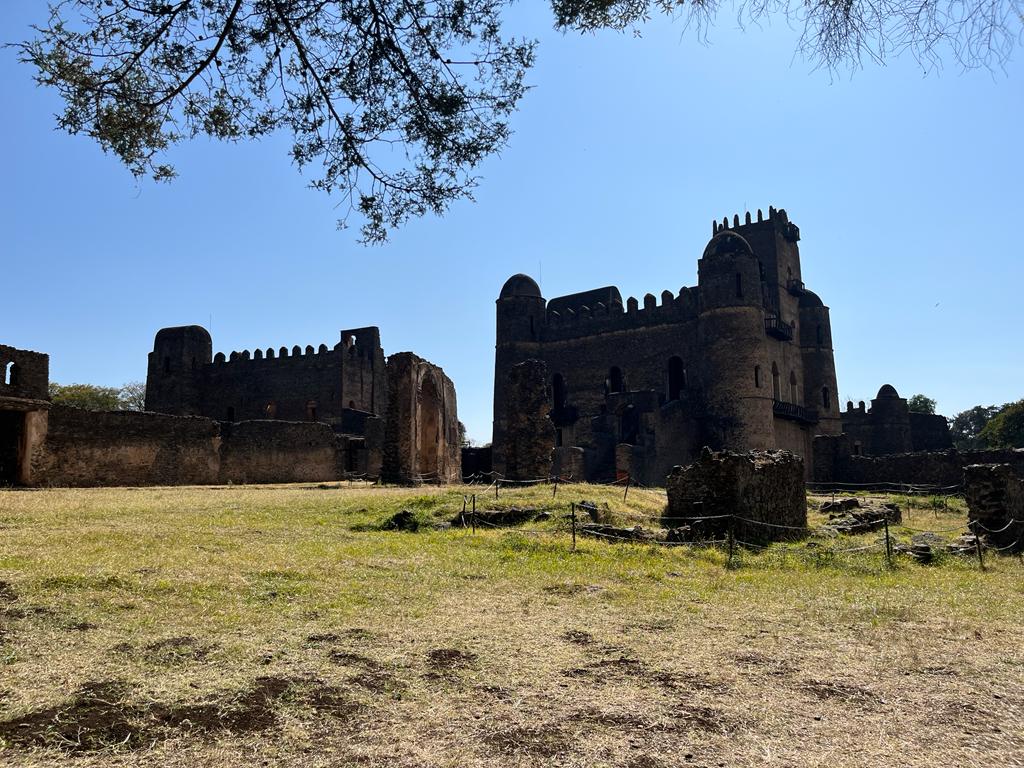
Wandering around the compound is a unique experience in Africa, as it gives the feeling of being back in one of Europe’s middle age towns. Nonetheless, the conditions of the castles vary from one another as they have been affected by the Sudanese invasions or World War II bombs.
7. Immerse into the Merkato Experience
Apart from being the biggest open-air market in Africa, Merkato is also characterized for being the most overwhelming place in the whole country, without any doubt. Some may recommend going to Merkato with a guide as sometimes it can be excessively overwhelming, however, I think that to fully experience it is better to go on your own.
Any kind of goods are sold in Merkato, from cows to washing machines, and it is the place from where all the goods are distributed to the rest of the country. I will also recommend going to one of the rooftops in the buildings of Merkato to truly realize the dimensions of the market.
Although it is possible to find souvenirs and touristic items, I would recommend buying them on Churchill Avenue as prices for these kinds of products are higher in Merkato.
8. Visit Tribes in the Omo Valley
Although I am not the biggest fan of the tribal experiences, opinions about it are very diverse, and it is one of the main reasons why Ethiopia receives tourists every year. Therefore, I felt like I should include it among the top things to do.

In order to visit tribes like the Mursi or the Hammer, among the most isolated and popular ones to visit, it is necessary to arrange it through a local guide. During the experience, they will let you know how these people live and their traditions. Also, they will have a preset schedule including dances or something of that sort.
You will also be constantly asked to pay to take pictures of them, buy souvenirs or just give them tips to support their community. While it may seem good to help these communities, I have mixed feelings about it, as some of their traditions include the perpetration of gender-based or infant-oriented crimes.

Wanna know how to pack like a pro? Well for a start you need the right gear….
These are packing cubes for the globetrotters and compression sacks for the real adventurers – these babies are a traveller’s best kept secret. They organise yo’ packing and minimise volume too so you can pack MORE.
Or, y’know… you can stick to just chucking it all in your backpack…
Get Yours Here Read Our ReviewBackpacker Accommodation in Ethiopia

Ethiopia does not have a fully developed backpacking or touristic infrastructure. Therefore, the availability of accommodation for people visiting the country is quite limited and, many times, oriented toward luxury visitors.
When traveling around Ethiopia, don’t expect to find fancy hostels with a nice bar and a great backpackers’ party scene.
However, you can still find very decent options around the country to sleep in clean and affordable places. In addition, the kind of travelers you will meet in these places will certainly be on the same page as you, looking for adventure and real experiences.
Addis will be the destination where you can more easily find accommodation as is the most developed part of the country by far. Outside of Addis options are more limited and, as was mentioned, in the touristic destinations, accommodation is more oriented towards the rich.
It is also important to bear in mind that Ethiopia is not very digitized, hence, in some places, it is just better to try to find accommodation in the old-school way. Get out your map and check out the options you have around you.
The Best Places to Stay in Ethiopia
| Destination | Why Visit! | Best Hostel/Guesthouse |
|---|---|---|
| Addis | Basic accomodation with good cleanliness standards and properly located. | Mad Vervet Hostel |
| Lalibela | Cheap private options in a convenient location | Mini Lalibela Guest House |
| Gondar | Simple Backpackers’ place which will allow you to meet fellow travelers | Lodge De Chateau |
| Bahir Dar | Acceptable comfort and cleanliness standards for a low price. Close to the lake | Yiganda Hotel |
| Arba Minch | Stunning room with an unbeatable view and friendly hosts. | Exquisite Room by the cliff side |
Ethiopia Backpacking Costs
The costs of backpacking Ethiopia depend a lot on two factors: the number of organized activities you want to get involved in and how keen you are on living the local way during your stay.
As it was mentioned in the previous sections, for some of the main attractions in Ethiopia, like the Simien Mountains, the Omo Valley, or Danakil Depression, it is necessary to hire guides with transportation and expertise in the area visited. These guides are used to organize excursions for wealthy visitors, which makes them expensive. In addition, costs like entrance fees and car rental are high in Ethiopia.
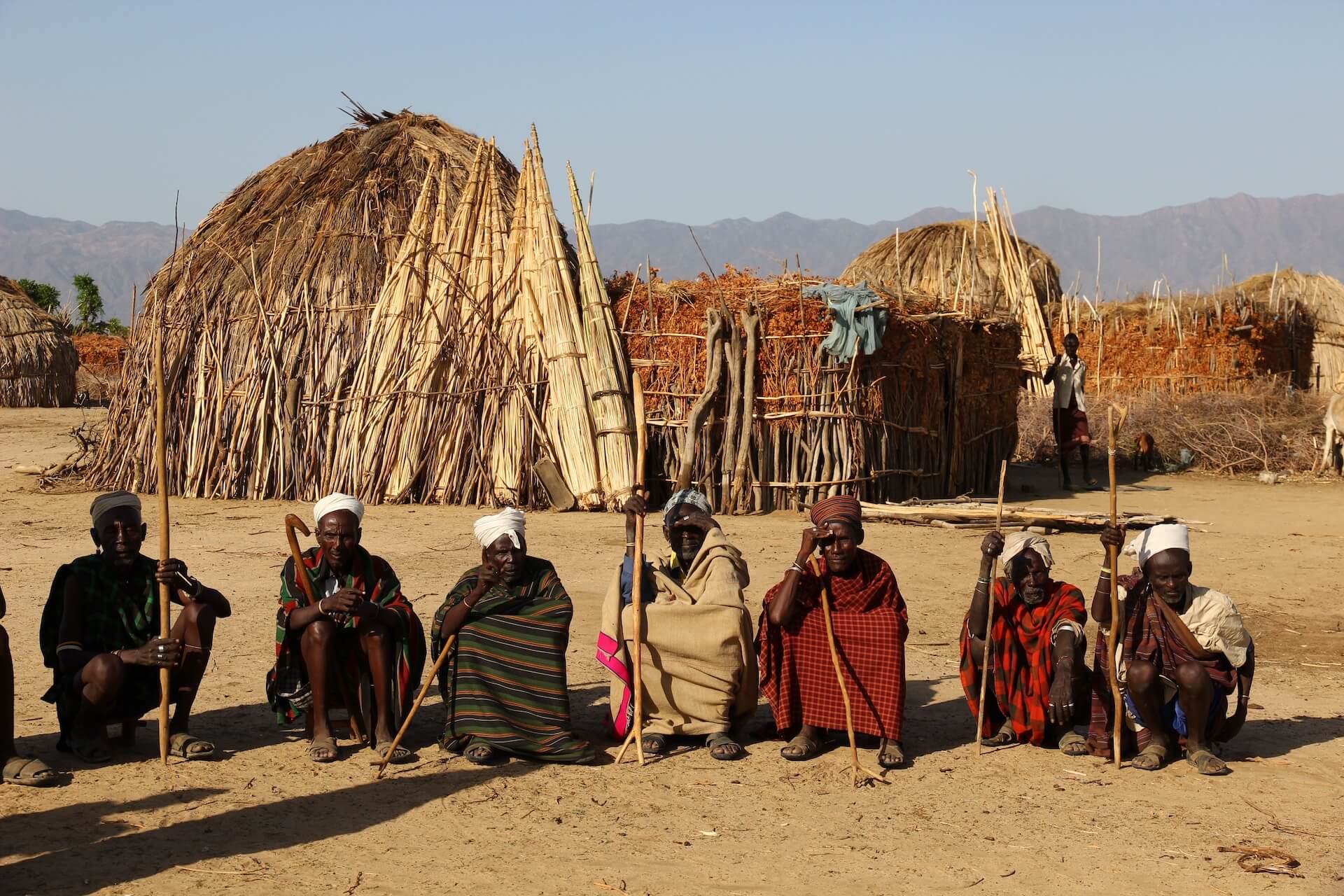
The other main determinant of your expenses will be how dependent you are on living by Western standards. If you decide to eat and drink in local places, and you are not too exquisite about the places you sleep at, then money in Ethiopia can go for a long time.
However, be warned that both the food and the accommodation standards differ hugely from the ones in your country of origin. Another important aspect will be whether you decide to fly, hire a driver or move around by public transportation.
Therefore, backpacking Ethiopia on a tight budget can be quite challenging as it does not offer too many middle-range options in terms of accommodation, transportation, activities, or food. However, I don’t think that anyone who is not up for a challenge would even think about backpacking Ethiopia.
Money in Ethiopia
The currency in Ethiopia is the Birr. Find out how much your money is worth today by using the up-to-date converter below. The biggest bill is 200 Birrs, so remember to arrange some space for the money once you have it.
It will be quite difficult to find Ethiopian currency out of the country so your best option will be to either withdraw from a bank or exchange at the forex bureau in the banks. In Addis it is easy to get money, however, when you head on to other destinations it can be difficult or even impossible. Hence, try to carry all the cash you will need from Addis.

Also, Ethiopia is a really cash-based economy and only in Westernized restaurants and accommodations you will have your credit and debit cards accepted, so prepare yourself to pay all the expenses in cash.
For all matters of finance and accounting on the road, The Broke Backpacker strongly recommends Wise – The Artist Formerly Known as Transferwise!
Our favorite online platform for holding funds, transferring money, and even paying for goods, Wise is a 100% FREE platform with considerably lower fees than Paypal or traditional banks. But the real question is… is it better than Western Union?
Yes, it most certainly is.
A Daily Budget in Ethiopia
| Expense | Broke Backpacker | Frugal Traveler | Creature of Comfort |
|---|---|---|---|
| Accommodation | $8 | $20 | $50 |
| Food | $5 | $10 | $25 |
| Transport | $4 | $15 | $50 |
| Nightlife | $2 | $10 | $20 |
| Activities | $20 | $35 | $50 |
| Totals per day | $39 | $80 | $195 |
Travel Tips – Ethiopia on a Budget
- Eat Local Food: Ethiopian cuisine is unique and despite it may be a bit of a shock at the beginning, you can grow to really love it. In local restaurants, you can spend 2-3$ per meal and end up completely full.
- Camp: Even though you can’t camp wherever you go when visiting National Parks like the Simien Mountains it will save you a lot of money (and also improve your experience) to pack your camping gear and enjoy sleeping in the wild.
- Use public transportation: while it can be challenging and uncomfortable, traveling around Ethiopia through public transportation is a hell of a rewarding experience, both for your wallet and your soul.
- Limit the amount of tour-required destinations: if you are on a tight budget it is better to reduce the number of activities that require hiring a guide and transportation. While there are amazing places to see in Ethiopia, the highlight of traveling here is getting fully immersed in its unique culture.
Why You Should Travel to Ethiopia with a Water Bottle
Although the streets can be dirty, please be responsible enough to not be a part of it. It is not only about spoiling the beauty of the places or climate change, the health of Ethiopians can be severely affected if the trash you throw away ends up in the river where they get their water from.
One way to get around this is by investing in a premium filtered travel bottle like the Grayl Geopress. You can filter any kind of water, save money on buying endless plastic bottles – and sleep easy knowing you’re not contributing to the plastic bottles lining our beautiful beaches.

Drink water from ANYWHERE. The Grayl Geopress is the worlds leading filtered water bottle protecting you from all manner of waterborne nasties.
Single-use plastic bottles are a MASSIVE threat to marine life. Be a part of the solution and travel with a filter water bottle. Save money and the environment!
We’ve tested the Geopress rigorously from the icy heights of Pakistan to the tropical jungles of Bali, and can confirm: it’s the best water bottle you’ll ever buy!
View on REI Read the ReviewBest Time to Travel to Ethiopia
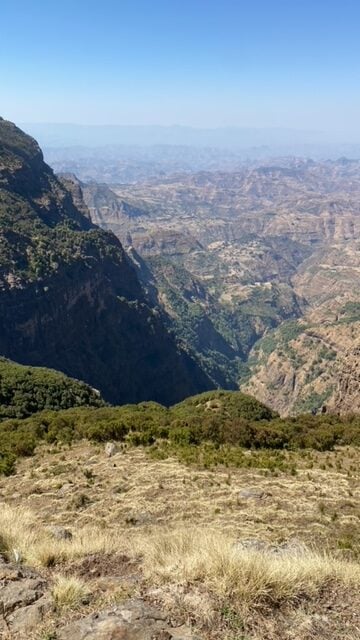
Ethiopia’s weather is divided into the rainy season and the dry season. The rainy season lasts for the months of the Western hemisphere summer, from June to September. The probability of getting rain during the rest of the year is very small.
Addis’ weather is mild during the whole year due to its high altitude (2500m) and, besides the rainy season, temperatures stay between 10º and 25º C.
In areas with lower altitudes, it can get hotter. The months before the rainy season are usually the hottest ones throughout the country. Among the touristic destinations, places like Danakil Depression, where temperatures are high throughout the whole year, or the Simien Mountains, where it is cool the whole year, follow their own rules.
What to Pack for Ethiopia
While it doesn’t have strict dress rules, Ethiopia is a conservative country, and as such some kinds of outfits, especially when it comes to women, may be quite shocking for the local people.
Also, when visiting churches, like Lalibela, your shoulders and legs should be covered. In addition, women must cover their hair.
Travel Security Belt
This is a regular looking belt with a concealed pocket on the inside – you can hide up to twenty notes inside and wear it through airport scanners without it setting them off.
Microfiber Towel
Hostel towels are scummy and take forever to dry. Microfibre towels dry quickly, are compact, lightweight, and can be used as a blanket or yoga mat if need be.
Petzl Actik Core Headlamp
A decent head torch could save your life. If you want to explore caves, unlit temples, or simply find your way to the bathroom during a blackout, a headtorch is a must.
‘Monopoly Deal’
Forget about Poker! Monopoly Deal is the single best travel card game that we have ever played. Works with 2-5 players and guarantees happy days.
Hanging Laundry Bag
Trust us, this is an absolute game changer. Super compact, a hanging mesh laundry bag stops your dirty clothes from stinking, you don’t know how much you need one of these… so just get it, thank us later.
Staying Safe in Ethiopia
As a developing country severely affected by war, Ethiopia faces different challenges that may affect the stability and safety of certain areas. However, if you avoid those areas, traveling in Ethiopia is not dangerous compared to other African countries.
In November 2022, the Federal Government of Ethiopia and the Tigray People’s Liberation Front signed a peace agreement to put an end to the two years war in the northern region of Tigray. Even though the situation is improving, traveling to Tigray is still strongly discouraged.
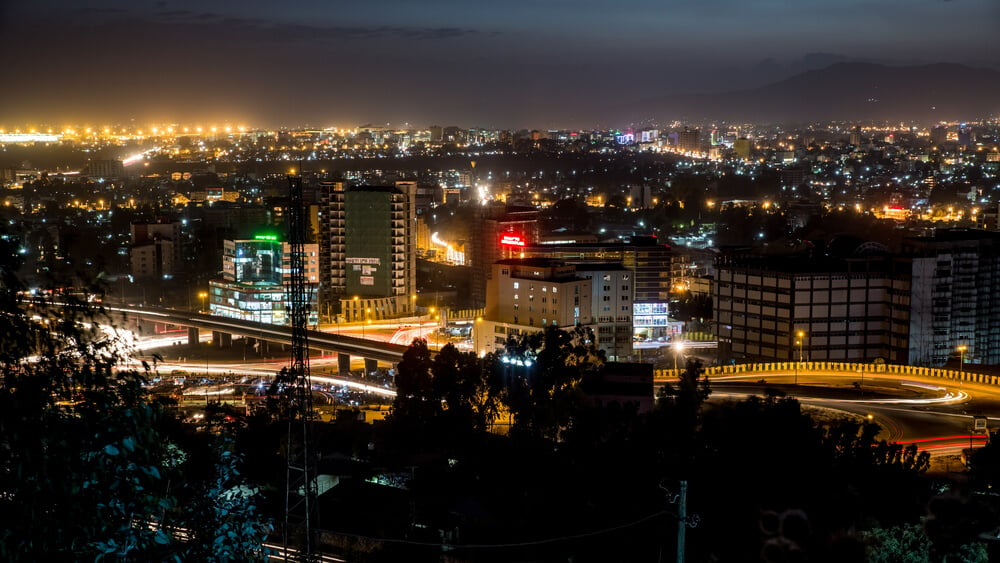
This Ethiopia backpacking guide doesn’t include any recommendations for places or things to do inside the Tigray region. Other areas of the country may be affected by sudden violent clashes so it’s important to stay updated on the situation.
Besides the danger of conflict, in touristic places, you can find petty crime and the usual scamming. Violent crime in Ethiopia is unusual, however, it is important to avoid walking around during the night, especially while in Addis. Apart from that, try to avoid flashing any valuables and keep an eye on your belongings.
Sex, Drugs, and Rock ‘n’ Roll in Ethiopia
If you are looking for a destination to go crazy, meet tons of backpackers, and stay every night until the sun comes up, then you should look for a different destination. A trip to Ethiopia will not be remembered by its wild nights out.
This doesn’t mean that you can’t unwind by drinking a couple beers in the local bars spread all over the country. In addition, Addis has an active nightlife with plenty of options to party until the late hours of the night. It is possible to find hard drugs in Addis’ nightlife, however, I don’t believe it is worth taking the risk of getting caught.
In the case of weed, due to the Ethiopian bond with the Rastafari community, it is, in the framework of a conservative country, more socially acceptable. However, again, you don’t want to be caught in an African country carrying drugs around. My recommendation is to stay away from illegal drugs during your stay in Ethiopia.
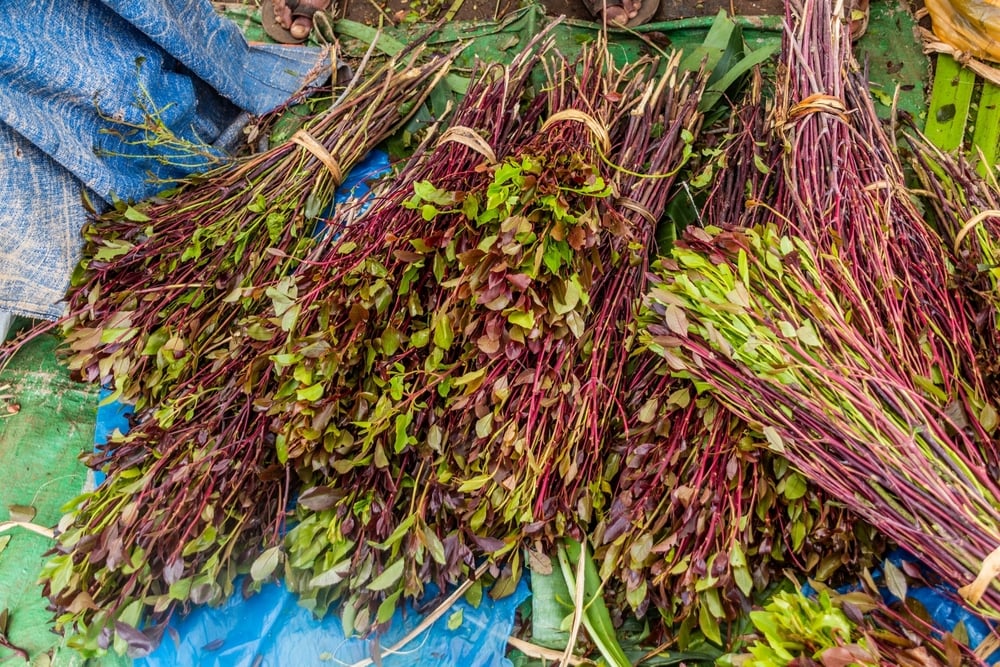
However, khat is very popular and legal in Ethiopia. Khat is a stimulant plant that has to be chewed for hours in order to truly feel its effects. Its cheap price and legal condition make it a part of the daily life of many inhabitants of the Horn of Africa and the Arabian Peninsula.
Ethiopian society is very conservative in general and, as such, it may be difficult to get involved with locals in short periods of time. In addition, a very low percentage of the local population speaks English, which reduces the possibility of establishing bonds. Nonetheless, in Addis’ nightlife, you may end up meeting lots of local and international open-minded people.
Homosexuality is illegal in Ethiopia and if accused you may even end up spending some time in jail. Besides being illegal, Ethiopian society does not approve of homosexuality either, so it is better to refrain from any kind of behavior that may lead someone to think that you are an LGBT traveler. If traveling with your partner, remain cautious even in your accommodation.
Getting Insured BEFORE Visiting Ethiopia
ALWAYS sort out your backpacker insurance before your trip. There’s plenty to choose from in that department, but a good place to start is Safety Wing.
They offer month-to-month payments, no lock-in contracts, and require absolutely no itineraries: that’s the exact kind of insurance long-term travellers and digital nomads need.
SafetyWing is cheap, easy, and admin-free: just sign up lickety-split so you can get back to it!
Click the button below to learn more about SafetyWing’s setup or read our insider review for the full tasty scoop.
How to Get Into Ethiopia
The most common and recommended way to enter Ethiopia is through Addis Ababa Bole International Airport. Ethiopian Airlines is very well connected worldwide, while there are other airlines that also operate in the country.
Entering by land to Ethiopia is generally not advisable due to insecurity in the borders and the unstable political situation of neighbors like Eritrea, Somalia, and South Sudan. Djibouti will probably be the safest land border and there is a direct train that connects Addis and Djibouti.
Entry Requirements for Ethiopia
Ethiopia has an online visa service, which allows visitors to apply for their visas through the immigration website. Tourists, as of May 2023, have two possibilities for visas:
- 30 days: 82 USD
- 90 days: 202 USD
The approval process for the tourist visa usually takes 3 working days.
How to Get Around Ethiopia
Distances in Ethiopia can be very long. If you add this to the fact that some of the touristic destinations cannot be reached by public transportation or with your own car, during the time you spend in Ethiopia you will probably have to move by different means of transportation.
Ethiopian Airlines is the only airline that operates flights between domestic destinations. The flights can be booked in person in the Ethiopian Airlines office in the Hilton Hotel in Addis Ababa.
The prices of one-way flights are around 70$ if you have entered the country with Ethiopian Airlines and around 140$ if you haven’t.
The extent to which you will have to resource to flights depends on the budget and time constraints that you have, however, in order to reach the northern cities it may be advisable to take a flight to save a whole day of public transportation
Traveling by land in Ethiopia can be quite an experience, as it is the only way to see how people in rural areas truly live and to admire the astonishing landscapes of the country.
Although interurban roads are, in general terms, in good conditions, it is difficult to find car rental companies for reasonable prices to move outside of Addis.
Hence, if you are not willing to move around the country by public transportation, you will have to hire a driver with their own car, which can turn out to be quite expensive. On the other hand, having a driver hired for everything will spare you from having to find guides in places like the Simien Mountains or the Omo Valley.
Your last option is to move around by public transportation, which is the most immersive and cheap means of transportation, however, it will also be the more difficult. There is no online information about buses and the level of English is generally low in Ethiopia, so finding the right bus can be a hell of a challenge. It all depends on your desire for adventure and your financial capacity.
Onwards Travel from Ethiopia
As mentioned in previous sections, traveling by land to neighboring countries may be difficult due to security risks. However, if possible, backpacking Kenya would probably be the more attractive option to continue with the adventure by land. There are buses that can take you to the bordering town of Moyale where you can get into Kenya and explore the off-the-beaten-path northern part of the country.
In addition, the wide range of connections that Ethiopian Airlines has with other African states will allow you to take a flight to other destinations inside the continent. Kenya, Uganda, or Tanzania are usually the cheaper options available, however, going to other destinations, like Madagascar, would allow you to save a lot of money compared to the flight prices you would pay from your home country.
Working and Volunteering in Ethiopia
Finding job opportunities in Ethiopia is not an easy task and it is mainly available in the humanitarian, international relations, and development fields. In addition, job permits in Ethiopia are not easily accessible to foreigners.
There is also not a huge digital nomad scene. The lack of touristic affluence, which usually preludes digital nomadism, together with (relatively true) prejudices about internet accessibility or living conditions, has dissuaded Ethiopia from being a part of this phenomenon.
While living conditions may not be as comfortable as in other destinations, working as a digital nomad in Ethiopia will also provide you with the opportunity to live an absolutely off-the-beaten-track experience and to understand the way of living of this unique society. Regarding internet accessibility, internet access has improved a lot in the last years and the majority of Westernized accommodation includes power generators for power cuts.
During the time I have spent in Ethiopia, I have met some remote workers who were able to maintain their job after living in Ethiopia for more than two years. It must also be said that Addis would be the best, and maybe the only place where you would be able to establish yourself as a digital nomad.

A new country, a new contract, a new piece of plastic – booooring. Instead, buy an eSIM!
Jetpac eSIMs work just like an app: you download it, pick your plan, and BOOM! You’re connected the minute you land. It’s that easy.
Read about how e-Sims work or click below to see one of the top eSIM providers on the market and ditch the plastic.
Grab an eSIM!Teaching English in Ethiopia
English is not widespread in Ethiopia, which means that there is an enormous demand for English speakers in the country. However, in many cases knowing the local language may be required. Furthermore, you will most probably have to be sponsored for your job permit by your employer, who may not be willing to go through such a process if you are considering a short-term stay in the country.
Volunteering in Ethiopia
Volunteering is necessary everywhere and lending a hand through this type of experience is a really beneficial experience both for society and for yourself. Having said this, it is undeniable that there are places that need it more than others and Ethiopia is undoubtedly one of those places. Hence, I would highly encourage you to come to Ethiopia for your volunteer experience.
If you want to find volunteer opportunities in Ethiopia, then we recommend that you sign up for Worldpackers – a volunteer platform that connects local hosts directly with traveling volunteers.
Whenever you are volunteering, do stay vigilant especially when working with animals or children. Volunteer programs run through reputable work exchange programs are very well managed.
Ethiopian Culture
As it has been intensely stated in this guide, Ethiopian culture is absolutely unique and diverse mainly because of religion and ethnic diversity.
Ethiopia is one of the most ancient countries in the world and also the second country to adopt Christianity as a state religion in the 4th century, only after Armenia.
While dependent on the Egyptian Coptic Church until the 20th century, Ethiopia has been isolated from the rest of the Christian states for many centuries, which has led the Ethiopian Orthodox Church to develop a lot of unique characteristics compared to the rest of the Christian world.
Ethiopian orthodox followers do not eat pork, and do not eat animals that they haven’t killed themselves, with the exception of cows killed in orthodox butcheries. They also fast for more than half of the year. Furthermore, the high percentage of Muslims in the country and the peaceful coexistence of both religions is another fascinating feature of Ethiopian religiosity.

Ethiopia is populated by more than 90 different ethnic groups with radically diverse traditions and which are generally geographically distributed throughout the country, although a fair amount of coexistence takes place in different areas.
The sizes of the ethnic groups are very varied. The main ones are the Amhara, Tigrinya, Oromo, and Somali. On the other hand, very small ethnic groups inhabit the Omo Valley and other areas in the south, maintaining intact their ancient tribal traditions and ways of living. The interethnic relations in the country have been characterized by continuous conflict and power struggles until nowadays.
From personal experience, I can tell that it is better to refrain from discussing politics and interethnic conflicts, as it is a very delicate matter, about which Ethiopians have very strong opinions.

Ethiopia is also known for its vibrant music, dance, and art scenes. Traditional Ethiopian music is characterized by its use of unique instruments such as the masinko, krar, and washint, as well as complex rhythms and vocal harmonies. Ethiopian dance is also highly expressive and often incorporates intricate footwork and gestures.
Ethiopian society is also very closed towards foreigners, which can be wrongly interpreted as Ethiopians being rude or skeptical. The truth is that the lack of tourism and of a colonial past means that they are just not used to foreigners and they will observe you with intense curiosity.
However, once you pass the initial cultural barrier and manage to communicate with them, you will realize that they are generous and open to meeting new people in many cases. I can’t count the times I have been offered to share lunch with someone while walking down the street.
Useful Travel Phrases for Ethiopia
The vast amount of ethnic groups in the country also translates into a vast amount of languages spoken in Ethiopia. Estimates establish the number of languages is around 80. Among them, Amharic is the most widely spoken language and used by the government. Nonetheless, I wouldn’t say that more than half of the population of the country speaks Amharic.
Amharic is a Semitic language with a unique alphabet. This makes it quite difficult for a foreigner to learn and understand it in a short period of time. Other languages spoken in the country are Oromo, Somali, and Tigrinya.
The level of English of the population is low in Addis, while practically non-existent in the rest of the country.
Hence, here I have left some useful phrases to get you through this experience:
Hello: Salam neh (for man) / nesh (for women)
How are you?: Indet neh / nesh
Good morning: Indemin aderk /adesh
I don’t speak Amharic: Amarinya ailnagerim
Sorry: Yqerta
Enjoy: Tedeseti
No problem: Chigrilam
Where is the toilet?: sente bet yate naw?
Help: Meridati
Beautiful: Konjo
Good: Arifno
What to Eat in Ethiopia
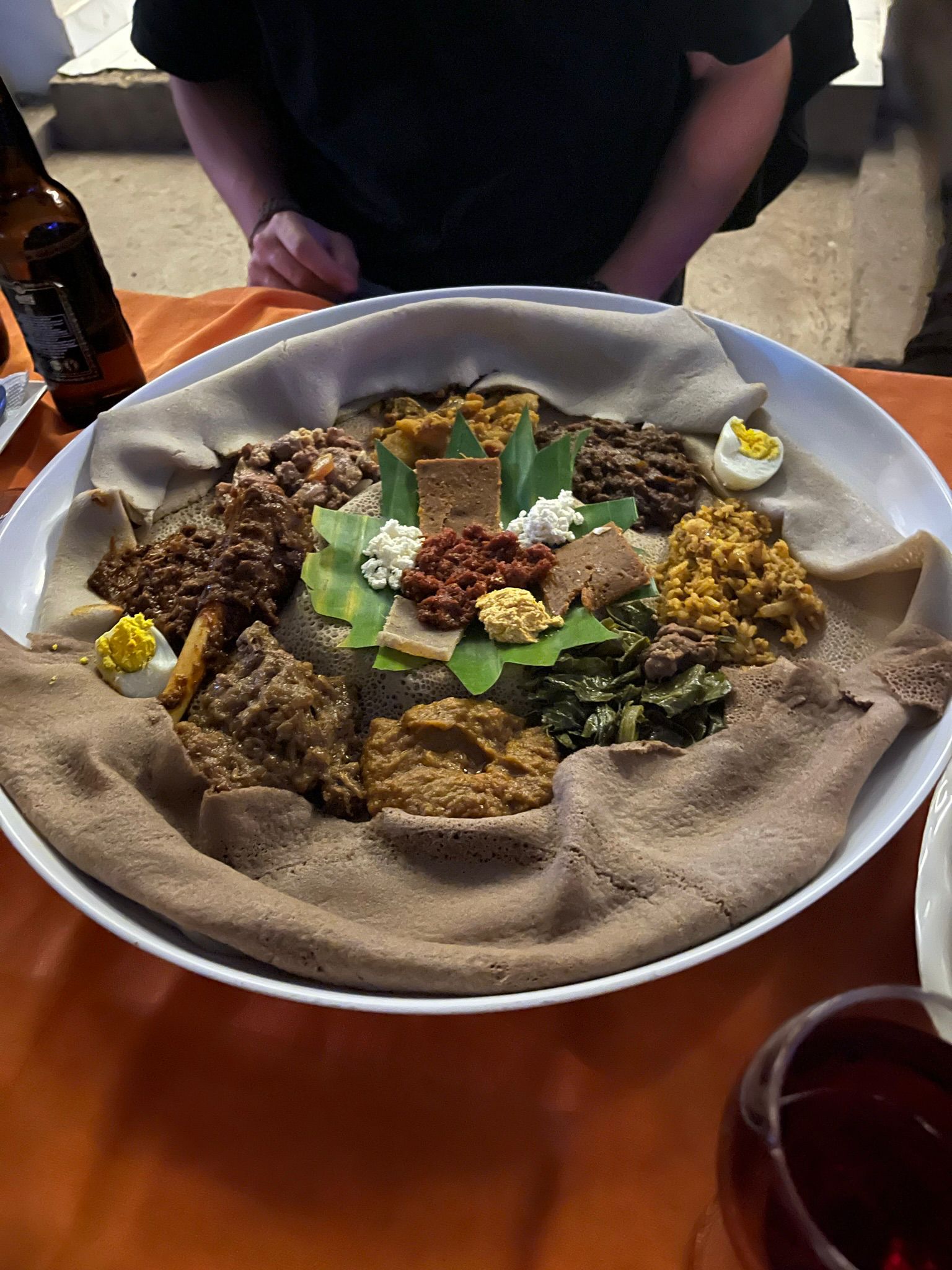
One of Ethiopia’s main cultural or economic sources is coffee or “bunna” in Amharic. The word coffee comes from the Kaffa region located in southeast Ethiopia.
Apart from being one of the best coffees in the world, Ethiopian coffee is also the center of many social meetings, in which the hosts cover the floor with grass, light up some smelling species, and offer snacks to eat.
While walking around you will find plenty of women preparing and selling coffee in the street. Don’t hesitate to have one and see if you are lucky and they perform at least a part of the ceremony.
Food in Ethiopia may vary from one region to another or from the fasting period to the non-fasting period, however, every Ethiopian dish is served on top of an injera. The injera is a very flat and soft kind of bread, which is made of an abundant cereal in Ethiopia called teff.
It doesn’t have a lot of flavor, although it may taste sour if you are not used to it. On top of the injera, all kinds of stews and foods are served. The injera is used both as a plate and as cutlery, as you have to cut it, only with your right hand, and grab the food on top with it.
Must-Try Dishes in Ethiopia
Tibs: one of the most common Ethiopian dishes. It is a stew made of beef or lamb cooked with sauce, spices and vegetables like onions and, sometimes, tomatoes.
Doro wat: is the dish eaten in celebrations and one of the favorites of Ethiopians. It is a chicken (doro) stew cooked with over 40 spices and boiled eggs. It can be very spicy.
Shiro: it is kind of a dense curry made out of chickpeas and different spices. It is also one of the most common dishes and very popular during the fasting season. It can also include chilly.
Kitfo: it is made of spiced dices of raw beef. One of the spices used to prepare it is the mitmita, a common Ethiopian spice, which is very hot.
Tere siga: it is basically raw beef cut in medium size pieces. It is served with a spicy sauce, in which you can dip, helped by the injera.
A Brief History of Ethiopia
Ethiopia’s earliest known history is traced back to the kingdom of D’mt, which is believed to have existed around 1000 BCE. The kingdom of Aksum, which emerged in the 1st century CE, is considered one of the greatest empires in ancient Africa.
Aksum was known for its advanced architecture, trade, and Christianity. The kingdom’s influence extended throughout the region, including parts of modern-day Yemen and Sudan.
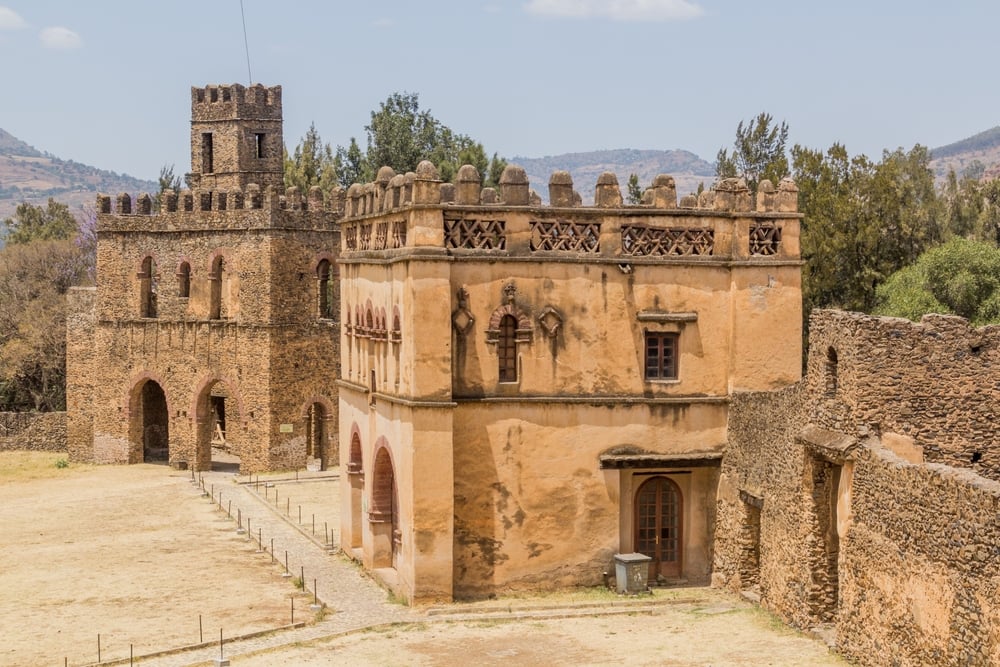
During the 16th century, Ethiopia went through a period of political instability, with several rival factions vying for power. The country was eventually reunited under Emperor Fasilides, who founded the city of Gondar as his capital.
In the 19th century, Ethiopia faced increasing pressure from European powers seeking to colonize the country. However, Emperor Menelik II successfully resisted these efforts, defeating Italian forces at the Battle of Adwa in 1896.
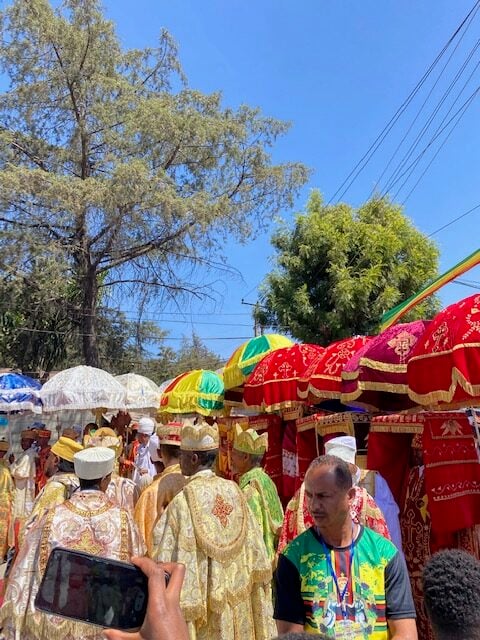
Ethiopia underwent significant changes during the 20th century. In 1930, Haile Selassie became Emperor of Ethiopia, ushering in a period of modernization and economic growth.
However, his reign was also marked by political repression and a lack of democracy. In 1974, a socialist military junta known as the Derg overthrew the monarchy and established a Marxist-Leninist government. This period was marked by political violence, famine, and economic decline.
In 1991, the Derg was overthrown by rebel forces led by the Ethiopian People’s Revolutionary Democratic Front (EPRDF). The EPRDF established a new constitution, and Ethiopia transitioned to a federal system of government.
Despite some progress in democracy and human rights, Ethiopia has also faced challenges in recent years, including ethnic tensions, political unrest, and conflicts in regions like Tigray.
Overall, Ethiopia has a rich and complex history, with a legacy that has influenced the region and the world.
Rastafari Movement
Haile Selassie, who was also known as Ras Tafari, was a figure of great importance to the Rastafari movement. Many Rastafarians believe that he is a messiah and that he represents the return of Jesus Christ, based on the interpretation of biblical texts.

Haile Selassie himself was a devout Ethiopian Orthodox Christian and did not endorse the Rastafari movement, but he was respected by many members of the movement for his role in promoting pan-Africanism and his opposition to colonialism.
The establishment of Shashamane as a settlement for Rastafarians was a significant event in the history of the movement. It allowed Rastafarians from around the world to settle in Ethiopia and connect with their African heritage. Today, the town is home to a community of Rastafarians who have built their own cultural institutions and practices, including the Nyabinghi drumming ceremonies and the celebration of Ethiopian culture and history.

Things go wrong on the road ALL THE TIME. Be prepared for what life throws at you.
Buy an AMK Travel Medical Kit before you head out on your next adventure – don’t be daft!
Buy on REIFAQs About Backpacking in Ethiopia
A few commonly asked questions about traveling to Ethiopia…
Final Advice Before Visiting Ethiopia
Even though you may feel in a completely different world, please keep in mind that you are a human being surrounded by human beings.
Try people nicely and you will receive kindness from their side. Please don’t treat them as servers just because they are willing to accept ridiculously low amounts of money to do things for you. Also, don’t be the kind of imbecile who thinks everything around them is just a part of the stage set to take his or her Instagram pictures.
If you want to take a picture of someone, ask for their permission and if it’s a child ask for the permission of an adult. Imagine what would happen if four Ethiopians went to a park in Europe and started to take pictures of four-year-old girls.
Also, while in Ethiopia, you will find lots of beggars, many of them children. I think that it is good to help those in need, but in the case of children, I would advise to avoid giving them cash. You can buy them food, books, or materials for school, but children are commonly used to bringing some cash home, even if they have to miss school to do so.
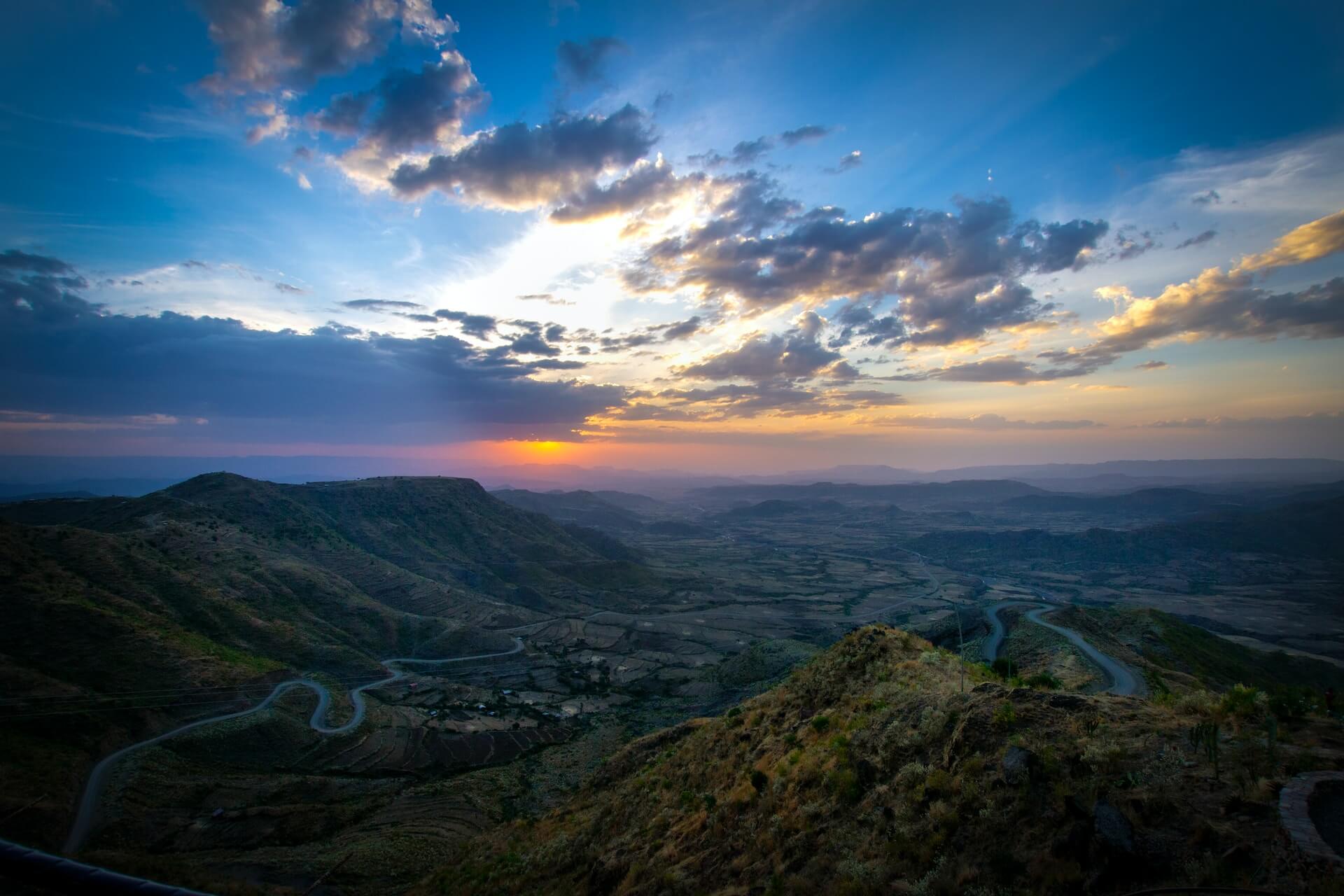
This guest post was contributed by Nico Prada, a traveler who is passionate about exploring new cultures and ways of life. For him, the main goal of any trip is to understand what drives the people who inhabit the place he is visiting. Easier to find having a couple beers in the local market than posting IG stories from a fancy rooftop.
Buy Us a Coffee!
A couple of you lovely readers suggested we set up a tip jar for direct support as an alternative to booking through our links. So we created one!
You can now buy The Broke Backpacker a coffee. If you like and use our content to plan your trips, it’s a much appreciated way to show appreciation 🙂









